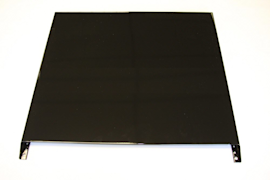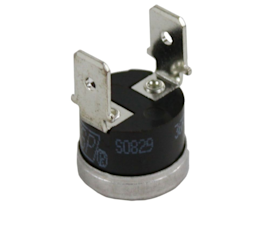Kenmore 722 series dishwasher error codes

These error code explanations can help you diagnose a problem with a Kenmore dishwasher that begins with model numbers 722.146.
For how-to information, visit the PartsDirect repair help section, which includes DIY help for major appliances, lawn and garden equipment, garage door openers, vacuum cleaners and more. Search for your model number to find a complete list of replacement parts for your dishwasher.
Not filling
Check that the water supply cut-off valve for the dishwasher is fully open. Check the water inlet supply hose for a kink. Unplug the dishwasher, shut off the water supply and disconnect the inlet supply hose from the inlet water valve. Check the filter screen on the inlet water valve for a clog-replace the valve if the filter screen is clogged. If the inlet screen isn't clogged, place the end of the water inlet supply hose in a container and briefly open the water supply cut-off valve to check water flow through the hose. If water doesn't flow through the hose, repair the water supply failure. If supply hose water flow is good, check the inlet guide assembly for clogs. Clear any clogs in the inlet guide. If the inlet guide is clear, check the wiring connections on the water inlet valve and reconnect any loose wires. If the wire connections are okay, disconnect the wires from the valve and check resistance through the water inlet valve using a multimeter. The meter should measure around 25 ohms of resistance. Replace the water inlet valve if the meter measures infinite resistance. If resistance through the valve is okay, reconnect the wires to the water inlet valve and check the water inlet valve's wire connections to the electronic control board (orange and black wires on BL6). Reconnect the water inlet valve wires if they're loose. If the wiring connections are okay, unplug the wires and check resistance through the black and orange water inlet valve wires that connect to the electronic control board. The meter should read the same resistance as for the water inlet valve. If the meter measures correct resistance through the wires, you'll likely need to replace the electronic control board because it's not sending the 12-volt DC current to the water valve during the fill portion of the cycle. If the water inlet valve buzzes during the fill portion of the cycle (indicating the control board is sending current to the valve) but the valve doesn't open, replace the water inlet valve. If the meter measures infinite resistance through the orange and black water inlet valve wires that connect to the electronic control board, find and repair the break in the wires.
Not draining
Check the sink drain or garbage disposal for a clog and clear any clogs you find. If the sink or garbage disposal drains okay, pull off the dishwasher drain hose from the sink or garbage disposal connection and check the end of the drain hose for a grease clog. Clear grease clogs from the drain hose. If the dishwasher uses an air gap, check the air gap for clogs and clear any clogs. Unplug the dishwasher and check the entire drain hose between the drain pump and the sink drain connection for clogs and clear any drain hose clogs. If you find no clogs in the drain path, check the dishwasher sump and drain pump for clogs and remove any clogs. If the sump and drain pump are clear, check the wiring connections on the drain pump and reconnect any loose wires. If the wiring connections are okay, disconnect the wires from the drain pump and check the resistance of the drain pump motor using a multimeter. The meter should measure between 4 and 5 ohms of resistance through the drain pump motor pins 1 and 2, pins 2 and 3 and pins 1 and 3. Replace the drain pump if the meter measures infinite resistance through any combination of pins. If resistance through the drain pump is good, check the wires to the drain pump wiring connections on the electronic control board (sky blue, black and white wires on YL3). Reconnect any loose wires. If wiring connections are okay, unplug the drain pump wires from the control board and measure resistance between sky blue and white wires, sky blue and black wires and white and black wires. The meter should read the same resistance as for the drain pump. If the meter measures correct resistance through the wires, you'll likely need to replace the electronic control board because it's not sending the current to the drain pump during the drain portion of the cycle. If the meter measures infinite resistance through any combination of the drain pump wires that connect to the electronic control board, find and repair the break in the wires. If the drain pump runs but doesn't pump water, replace the drain pump impeller because it's likely damaged or broken.
Water leak detected
Abnormally high circulation pump speed caused by low water level in the tub can cause the AE or E1 error codes. Water that leaks into the base of the dishwasher cabinet and trips the flood switch can also cause the AE or E1 code. Unplug the dishwasher and shut off the water supply. Check the dishwasher cabinet base for water. If water leaked into the base, find and repair the cause of the leak. Water could leak from the water fill line, water inlet guide, drain pump, drain hose, door seals or sump. After repairing the leak, remove water from the cabinet base. If the code appears and no water leaked into the cabinet base, disconnect the flood switch wires and check the resistance through the flood switch using a multimeter. The meter should measure infinite resistance when the cabinet base is dry. If the meter measures near 0 ohms, replace the flood switch because the switch tripped with the cabinet base dry. If the meter measures infinite resistance, reconnect the flood switch wires and check resistance through the flood switch wires that connect to the electronic control board (sky blue and yellow wires on NA8). The meter should read the same resistance as for the flood switch. If the meter measures near 0 ohms, find and repair the damaged flood switch wires that are shorting together. If the meter measures infinite resistance, then the AE or E1 code was likely caused by high circulation pump speed due to low water level. Check the configuration of the drain hose because water can siphon out of the dishwasher if the drain hose isn't installed properly. Follow the directions in the installation guide to properly install the drain hose.
Water overflow detected
The drain pump automatically runs when the FE code is displayed. A leaking water inlet valve or a stuck relay on the electronic control board can allow water to fill the dishwasher constantly. To check for a leaky water inlet valve, unplug the dishwasher and see if the tub continues to fill with water. If it does, shut off the water supply and replace the water inlet valve because the valve is letting water to flow into the dishwasher constantly. If water stops filling when you unplug the dishwasher, then you'll likely need to replace the electronic control board because the control board is constantly sending current to the water inlet valve.
Thermistor (temperature sensor) failure
Unplug the dishwasher and disconnect the wires from the thermistor on the heater. Measure the resistance through the thermistor using a multimeter. The meter should measure 11,320 ohms at 75 degrees (room temperature). Replace the heater assembly (which includes the thermistor) if the meter measures less than 1,000 ohms or more than 20,000 ohms. If thermistor resistance is good, reconnect the wires to the thermistor and check resistance through the thermistor wires that connect to the electronic control board (blue and red wires on RD6). The meter should read the same resistance as for the thermistor. If the meter measures correct thermistor resistance through the wires, you'll likely need to replace the electronic control board because it's not accurately detecting thermistor resistance. Find and repair the thermistor wiring failure if the meter measures infinite resistance or near 0 ohms through the sensor wires.
Locked up circulation pump motor
Unplug the dishwasher and check for an obstruction that's preventing the pump impeller from spinning. Remove any debris or foreign objects from the sump. If the pump impeller is clear, check the wiring connections on the pump and reconnect any loose wires. If the wiring connections are okay, unplug the wire harness from the motor and check the resistance through pins 1-2, pins 2-3 and pins 1-3 of the motor using a multimeter. The meter should measure between 8 and 20 ohms (resistance of the motor windings). Check the RPM sensor by measuring resistance through pins 7-4 and 7-5. The meter should measure 8,000 to 10,000 ohms. Replace the circulation motor if any resistance measurement is near 0 ohms or infinite resistance. If resistance through the motor windings and RPM sensor is good, plug the motor wire harness back in and measure resistance through the motor wires that connect to the electronic control board. Check resistance through the white and blue wires, the white and sky blue wires and the blue and sky blue wires on RD3. The meter should read the same resistance as for the motor windings. Measure resistance through the red and gray wires, then the red and violet wires on WH4 to check RPM sensor resistance. The meter should read the same resistance as for the RPM sensor. If resistance through the motor wires connected to the electronic control board are good, then you'll likely need to replace the electronic control board because it's not sending current to the motor. Find and repair the motor wiring failure if the meter measures infinite resistance or near 0 ohms through the motor winding or RPM sensor wires.
Heating failure
This code appears when water isn't heating or when the thermistor (temperature sensor) detects that water temperature is higher than 194 degrees. If water inside the dishwasher tub is extremely hot, measure water temperature using an accurate thermometer. If the thermometer measures water temperature near 190 degrees, then you'll likely need to replace the electronic control board because a stuck heater relay on the control board is causing the heating element to stay on constantly. Unplug the dishwasher to disconnect electrical power before replacing the control board. If water inside the tub doesn't seem to be overheated, then the code likely indicates that the heating element wasn't heating the water. Unplug the dishwasher and check the wire harness connections on the heating element and pressure switch. The pressure switch detects water flow to the heater and shuts off the heater if water flow is insufficient. A loose wiring connection on the heating element or pressure switch can prevent current from flowing through the heating element. Reconnect any loose wires. If the wiring connections are okay, unplug the wires from the heating element and measure resistance through the element using a multimeter. The meter should measure about 12 ohms of resistance. Replace the heating element if the meter measures infinite resistance. If the heating element is good, measure resistance through the thermistor on the heating element. The meter should measure 11,320 ohms at 75 degrees (room temperature). Replace the heating element (which includes the thermistor) if thermistor resistance is off by more than 10 percent because a faulty thermistor could be causing the HE code. If the heating element and thermistor are good, then you may need to replace the pressure switch or the electronic control board. You'll need to have a service technician examine the dishwasher and perform live voltage checks to determine whether the pressure switch or electronic control board is preventing the heating element from heating.
Diverter motor failure
Unplug the dishwasher and check the wire harness connections on the diverter motor and diverter position switch. Reconnect any loose wires. If the wiring connections are okay, unplug the diverter motor wires and check resistance through the motor using a multimeter. The meter should measure around 4,000 ohms of resistance. Replace the diverter motor if the meter measure infinite resistance. If the diverter motor is okay, measure the resistance through the diverter position switch with the switch plunger pushed in and with the switch plunger extended. The meter should measure infinite resistance with the switch plunger in one position and near 0 ohms of resistance with the switch plunger in the opposite position. If the meter measures the same resistance regardless of switch plunger position, replace the diverter position switch because it isn't detecting diverter position.
Most common symptoms to help you fix your dishwashers
Choose a symptom to see related dishwasher repairs.
Main causes: glass or popcorn kernel stuck in the chopper blade, drain line vibrating against the cabinet, debris in was…
Main causes: not using rinse aid, rinse aid dispenser failure, broken heating element, malfunctioning vent, drying fan f…
Main causes: damaged or stuck spray arm, leaking door seal, damaged door hinge, leaky heating element water seal, cracke…
Main causes: clogged kitchen sink drain, clogged drain hose, drain check valve damaged, drain pump failure, control syst…
Main causes: broken door spring, damaged or broken door hinge…
Main causes: broken door latch, tripped circuit breaker, broken heating element, faulty vent fan, sensor failure, contro…
Main cause: damaged rack height adjuster…
Main causes: improper loading, low water temperature, improper detergent dosage, detergent dispenser failure, spray arm …
Main causes: light switch beside the sink turned off, lack of power, bad dishwasher door switch, control system failure,…
Most common repair guides to help fix your dishwashers
These step-by-step repair guides will help you safely fix what’s broken on your dishwasher.

How to replace a dishwasher high-limit thermostat
Follow these steps to replace the high-limit thermostat in your dishwasher if prevents the heating element from heating.…

How to replace a dishwasher door outer panel
If your dishwasher door is dented or you want it to match your cabinets or other appliances, this guide shows how to rep…

How to replace a dishwasher thermal fuse
A completely dead control panel often indicates that the thermal fuse on the electronic control board is blown; follow t…
Effective articles & videos to help repair your dishwashers
Use the advice and tips in these articles and videos to get the most out of your dishwasher.

Get tips on completing essential holiday cleaning tasks to brighten your home.…

Learn about all the convenient features on our Sears PartsDirect website that make your parts purchases easier.…

Get answers to frequently asked questions about Sears and Sears PartsDirect.…